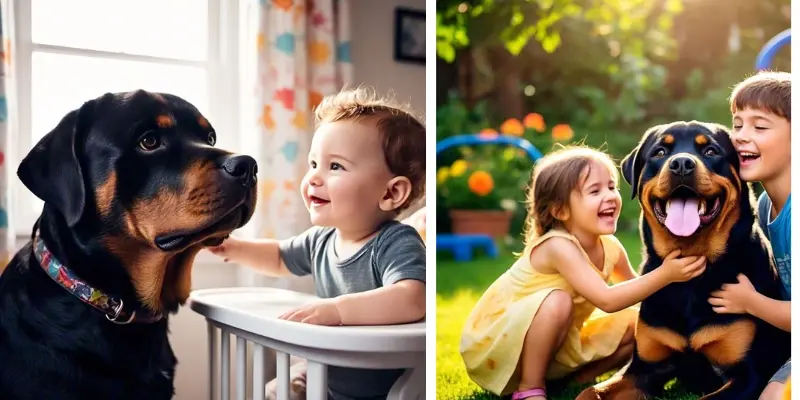Are Rottweilers Easy to Train by The First-Timers? Stats Say Yes—Here’s How
Published: 01 Jan 2025
If you’re thinking about bringing a Rottweiler into your home, you might be wondering: Are Rottweilers easy to train? With their strong, loyal, and protective nature, these dogs are often seen as both powerful and intimidating. But don’t let that fool you! While Rottweilers can be independent and a bit stubborn, they’re also super smart and eager to please.
In this article, we’ll explore what makes Rottweilers tick when it comes to training and discover their natural protective instincts. Plus, you will also find some tips on how to train a Rottweiler in a way that brings out the best of them.
Let’s dive in!…

Understanding Rottweilers: The Basics
Before we dive into training, it’s helpful to understand the Rottweiler breed a little better. These dogs aren’t just big and tough— underneath that strong exterior, they have a lot going.
History and Origins of the Rottweiler
Rottweilers were originally used as herding and guard dogs during the Roman Empire. They were used to drive cattle and guard meat markets, therefore, they’re naturally protective and have strong guarding instincts. This background also explains their solid, confident nature and willingness to protect what they see as their family or territory.
General Characteristics
- Intelligence: Rottweilers are known to be highly intelligent, which means they can pick up on commands quickly when trained correctly. They’re not a “set it and forget it” breed; they need mental stimulation and challenges to stay happy.
- Temperament: They are incredibly loyal and bond deeply with their family. They’re protective, but they’re also calm and loving when they feel secure. Rottweilers thrive in environments where they know they are trusted and cared for.
- Strength: Rottweilers are very strong and muscular, which makes them great protectors. This is a good thing, but it can also be tricky when training them. If not trained properly, their strength and confidence might make them try to take charge.
Personality Traits Influencing Training
Rottweilers are known for their confidence and independence. These traits can sometimes make them seem a bit stubborn, especially if they don’t see a reason to follow a command. But here’s the good news: their intelligence and eagerness to please their owners mean that, with the right approach, they can be trained to follow commands and perform tasks reliably.
When training a Rottweiler, understanding these natural traits is key. It’s not about breaking their will but rather guiding them with consistency, positive reinforcement, and clear boundaries. When they trust you as a leader, they’ll be much more willing to follow your lead.
In short, Rottweilers are an intelligent, confident breed with a strong protective instinct. Understanding these traits will set you up for success when it comes to training them!
Are Rottweilers Easy to Train?

So, are Rottweilers easy to train? The short answer is—it depends! But don’t worry, we’ll break it down for you.
What makes Rottweilers trainable
- Intelligent and Quick Learners
- Rottweilers are highly intelligent dogs, which means they can learn commands quickly.
- They enjoy mental challenges, so if you make training a fun game for them, you are half way there.
- Eager to Please
- They have a strong desire to make their owners happy.
- This makes them more motivated to listen and follow commands, especially when rewarded with praise or treats.
- Natural Problem-Solvers
- Their problem-solving abilities can be put to good use during training.
- They love to figure things out, making training engaging for them.
Challenges you might face
- Independent and Stubborn Streak
- Rottweilers have a strong-willed, independent nature.
- They may try to test limits, especially if they don’t see the reason behind a command.
- It can make them seem stubborn at times.
- Needs Clear Leadership
- They respect strong, clear leadership. If you’re inconsistent, they might get confused.
- Without firm guidance, they might push boundaries, so make sure your commands are always clear.
Tips for Success
- Early Socialization is Key
- Exposing your Rottweiler to different environments, people, and animals at a young age is crucial.
- It helps prevent overly protective or fearful behaviors, making training easier later on.
- Consistency in Training
- Rottweilers thrive on routine. Be consistent with commands, rules, and expectations.
- If you’re inconsistent, your Rottweiler might get confused and start testing boundaries.
- Positive Reinforcement Works Best
- Rottweilers respond best to positive reinforcement methods (treats, praise, toys).
- Avoid harsh or negative training methods, as this can lead to fear or aggression.
Are Rottweilers Protective?

Rottweilers are often known for their protective instincts, and it’s no surprise why—they were originally bred to be guard dogs. These traits are deeply embedded in their nature and can make them excellent protectors of their families and property. But what exactly makes Rottweilers so protective?
Natural Protective Instincts
Rottweilers have an instinctual drive to protect their family and home. Their strong guarding nature means they’re naturally wary of strangers or unfamiliar situations. They’re also very alert, making them good at noticing changes in their environment. This sharpness can make them excellent watchdogs.
How Protection Behavior Develops
- Innate Instincts:
- Rottweilers are born with a strong protective instinct. From a young age, they show a natural drive to guard their family and territory. This instinct is part of their genetic makeup.
- Bond with the Owner:
- Rottweilers develop a deep loyalty and bond with their owners. This bond fuels their desire to protect. The stronger the connection, the more protective they may become.
- Mature Behavior:
- As they grow older, their protective behavior usually becomes more refined. With experience and guidance, they learn to assess threats more accurately, guarding without being overly defensive or anxious.
Balancing Protection and Training
Understanding Their Protective Instincts
Their strong protective instinct means they’ll do whatever it takes to protect their family and home. However, without proper training, these instincts can turn into overprotectiveness or aggression.
Training to Differentiate Between Threats and Non-Threats
Training your Rottweiler to understand when to be protective and when to relax is key. They should be alert and defend their family if there’s a real threat, but they don’t need to react aggressively to every stranger or unfamiliar situation.
Consistency in Setting Boundaries
It’s important to be consistent with your training methods and boundaries. Rottweilers thrive on structure, and they need to know the rules of acceptable behavior. Rewarding calm and non-aggressive responses helps them understand how to behave in different situations.
Reinforcing Positive Behavior
The best way to ensure a well-behaved Rottweiler is by reinforcing positive protective behavior. Encouraging alertness without aggression will help them protect when needed but also stay composed around non-threatening people or situations.
A Balanced Companion
With the right approach, your Rottweiler can be both a loving family member and a reliable protector. Proper training helps harness their protective instincts in a way that ensures they’re protective but not overbearing. The result is a loyal, well-behaved dog who is an asset to your home.
7 Actionable Tips to Train a Protective Rottweiler
- Start Early
- Begin socializing and training your Rottweiler at a young age to help them understand appropriate protective behavior.
- Be a Strong Leader
- Rottweilers respect firm, confident leadership. Establish yourself as the leader to avoid dominance issues.
- Positive Reinforcement
- Reward calm and obedient behavior with treats, praise, or playtime. This encourages good behavior and strengthens their bond with you.
- Desensitize to Common Triggers
- Help your Rottweiler become accustomed to common situations, such as visitors or loud noises, to prevent overreacting.
- Avoid Aggressive Training Methods
- Never use fear-based training or aggression. This can make a protective Rottweiler anxious or fearful, which may lead to unwanted aggression.
- Practice Obedience Regularly
- Consistent obedience training reinforces control over your Rottweiler’s protective instincts. Practice commands like “sit,” “stay,” and “leave it” regularly.
- Provide Mental and Physical Stimulation
- Rottweilers need both mental and physical exercise. A bored dog may become overly protective or destructive, so engage them in activities like puzzle toys, walks, or agility training.
Tail End Thoughts
So, are Rottweilers easy to train? The answer is yes, with the right approach! They’re smart, eager to please, and naturally protective, which makes training both rewarding and important. With early socialization, consistency, and positive reinforcement, you can help them channel their protective instincts into calm, controlled behavior.
By setting clear expectations and building a strong bond, you’ll have a loyal, well-behaved Rottweiler who knows when to protect and when to relax. Enjoy the training journey, and watch your Rottweiler become the perfect companion!





